-
Posts
269 -
Joined
-
Last visited
Content Type
Profiles
News and Information
Tutorials
Product Reviews
Supplier Listings
Articles
Guitar Of The Month
Links and Resources
Forums
Gallery
Downloads
Posts posted by IPA or death
-
-
Nice find. And your plan sounds like a good one. Have at it!
What kind of wood is the strat back made of?
-
Really nice necks. How did you cut the scarf joints if you don't mind divulging? And what kind of finish is on the first neck?
Thumbs up.
Hi bud, thanks alot!
When the neck blanks are laminated (if appropriate) they are squared (Planer thicknesser comes in handy!) , then I cut the diagonal on a bandsaw, plane it by hand and use a sanding block on both sides... then glue. The hard part as when you have glue in between the two parts want to slide apart under preassure. so I knida wedge them and use an elaborate system of clamps.
Melvin Hiscocks book as a good way which is what I use.
They all are or will be finished with danish oil.
I had seen several ways of doing them on my internet search for a way that I could pull off. Found people that had done them with bandsaw jigs, table saws, etc. But I tried a bandsaw on some scrap and decided to do it with a handsaw
 . Worked well enough though. Yours is spotless so congrats.
. Worked well enough though. Yours is spotless so congrats.Never used danish oil. I'll have to look into it though, because you have a nice organic look to that neck. Looks like it would be very comfortable to play. I'm planning a build with a black walnut body and the danish oil looks like it may be perfect for that.
Once again, great stuff.
-
Correct-amundo. He developed the extended cutaway for the Washburn Nuno Bettencourt signature models in the late 80s or early 90s. They made an acoustic version too believe it or not. Then Stephens put out his own line of instruments; strat and tele models, with the same cutaway. Washburn still uses the cutaway for the Nuno line of guitars (except the cheaper imports, which have a regular 4 bolt joint).
The five bolt joint on this guitar is very stable. No movement at all. And I can see that it affects the tone in a negative way either. Obviously it's stable enough for a guy that has toured quite a bit in the last couple of decades.
It's not for everybody though, that's for sure. I don't know if any other visible players use the Nuno models. But I like this one a lot. Nice and lightweight.
I failed to mention that I put carbon fiber rods in the neck at the suggestion of some guys here. It really seems to have a nice tonal quality, although I'll never know what it sounded like without them
 . But for the little extra effort to put them in, I think it's something I'll do in future builds as well.
. But for the little extra effort to put them in, I think it's something I'll do in future builds as well. -
Really nice necks. How did you cut the scarf joints if you don't mind divulging? And what kind of finish is on the first neck?
Thumbs up.
-
This is the fifth guitar I've done (two from scratch, three using neck or body pre-made). I don't think I've ever actually put one of my builds on here before so I may as well do it now.
Alder body (a factory castoff from Washburn--slipped router on back trem cavity)
Maple neck with some cool flame and simulated Stephen's Extended Cutaway
Ebony fretboard and ebony binding which hides the fret ends (that was an accident)
original Floyd Rose
Dimarzio Steve's Special in bridge
SD '59 in neck
mini toggles for phase reversal and series/parallel
Tru-oil on neck and Minwax Tung oil finish on body
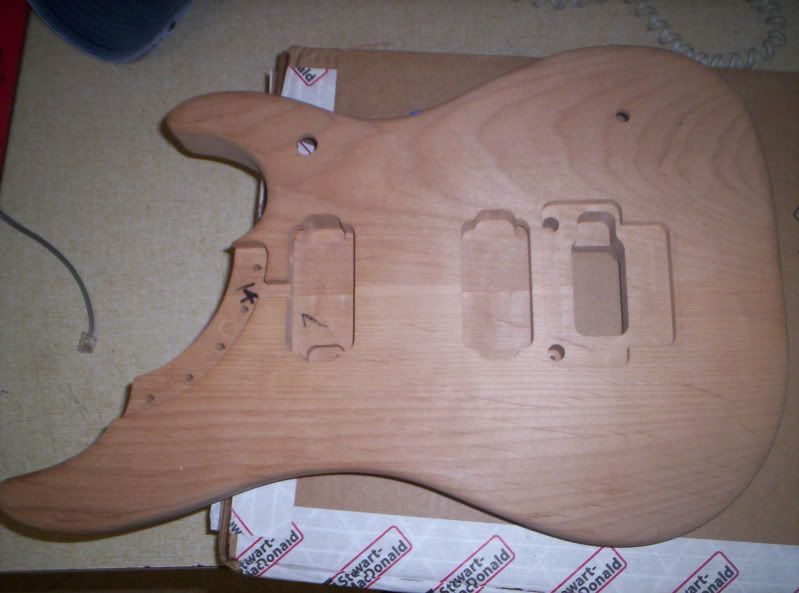
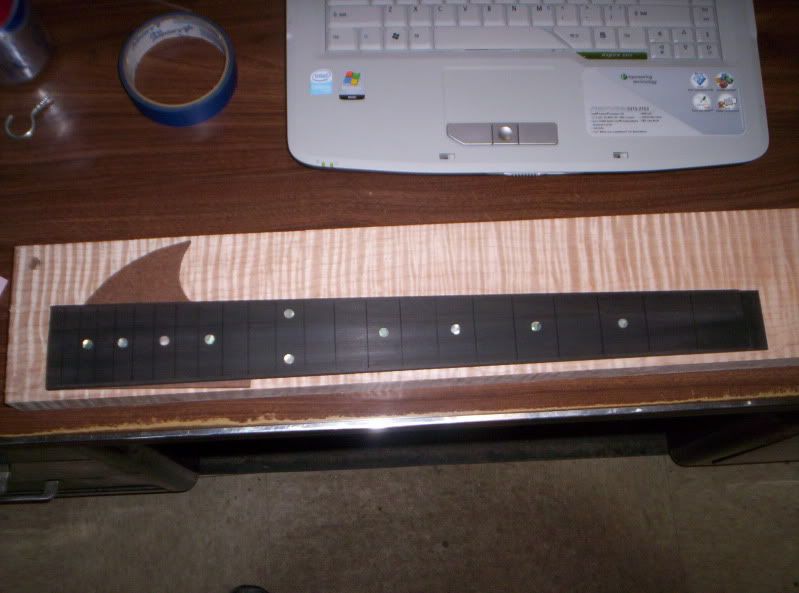
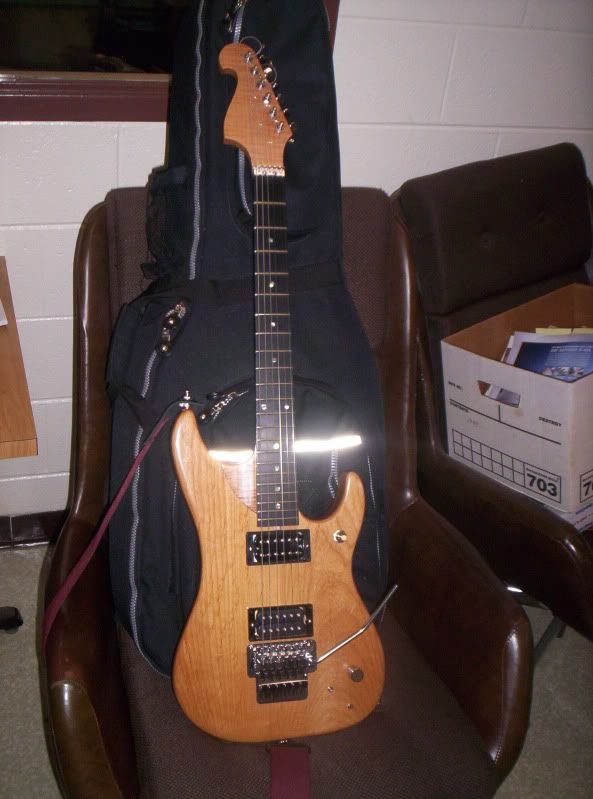
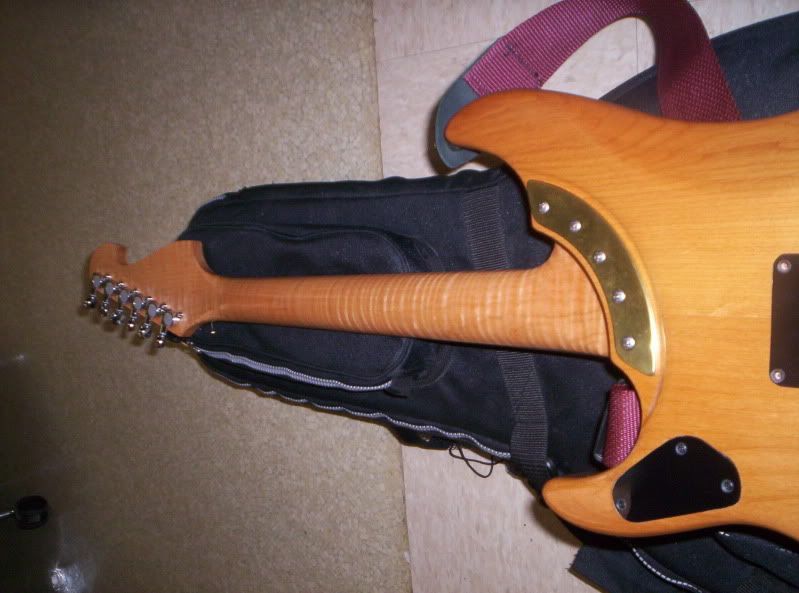
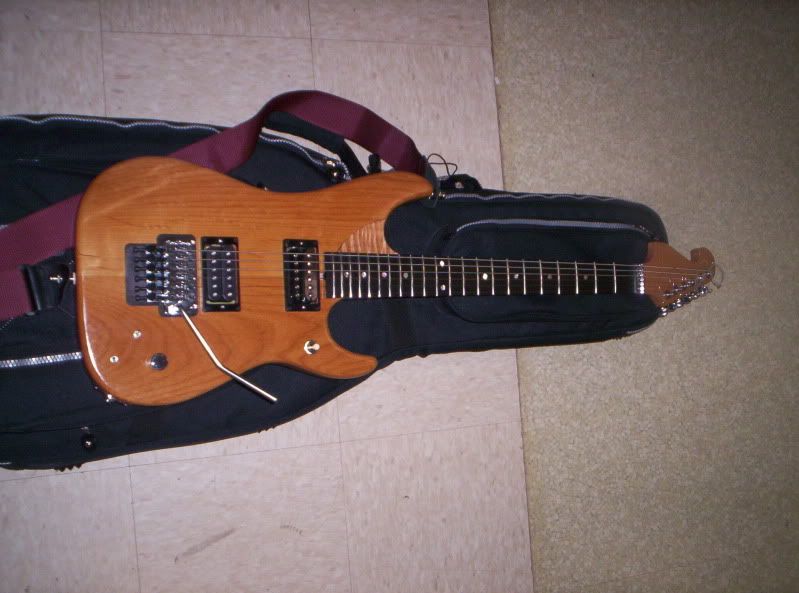
-
I've been wondering whether it's a bad idea to use the "sandwich" method of body building. No, I don't mean like Subway's Jared did. I'm talking about using boards thinner than the final thickness of the body glued together. Gibson made some guitars like this at one time, the Les Paul Recording and Deluxe models for a while.

Pete Townshend signature Gibson
I would assume there are other companies today doing the same in a cost cutting effort without making it well known.
But is there any tonal difference in a body put together in this manner than a two-piece which is at final thickness and glued together down the middle? Seems like a good way to make a cheaper body if the glue lines don't bother you.
Anyone use this technique or have any warnings, etc?
-
Looking good Mark. I'm always interested in teles, especially any new approaches a builder takes. I think yours will be a really beautiful version when you're done.
I used something similar to your router shelf/jig when cutting the binding channel in my LP a while back but it didn't work as smoothly as I had wished. If I ever do another guitar with binding I'll have to refine it or figure out a new way. Live and learn right?
Nice presentation on your website too. Very detailed and clear build story you've got going there. Good luck the rest of the way.
-
What's this 2K finish you're talking about and can it be found in the US that you know of? Looks really nice and you say that a can will do a body. I would like to look into that for future builds.
You're project looks really great btw. Keep up the good work Andy.
-
Looks like you've got a good start on it there. Nice tools and clean technique, so I'm sure it will be a really great guitar. I've got to get one of those Rigid sanders.
-
I use the regular tele cups and drill holes in it similar to the Electrosocket hole locations. That takes the expanding clip used in most teles out of play just like the Electrosocket does. The tricky part is holding it still to drill into it as it's pretty small and round to boot, but it can be done with a c-clamp on a table or something like that. Drill the holes from the outside.
-
Thanks for the response Pete. Unfortunately, that had no effect at all. I soldered the bare wire to ground and I still get nothing from the bridge pup.
One of these days I'll get a wiring done right on the first try...or not

-
I'm trying to wire up a guitar with 2 HBs, a 3-way pup selector, and a single volume only (no tone pot) and adding two mini toggle switches to facilitate series/parallel and phase reversal switching. I used the diagram below from Seymour Duncan's site to wire up the toggles.
I ran the wires from the bridge pickup to the switches, thinking it wouldn't matter which pup was wired to them. Was this wrong? It looks right according to the diagram at least.
I have a wire going from the hot output lug on the phase switch running to the middle lug on the volume pot and then to the guitar's input tip. The ground from the guitar's input runs to the back of the volume pot and all other grounds meet here. The problem is, when the phase switch is down there is no response from the bridge pickup.
Any ideas what I may have done wrong? Thanks for any input.
-
I'll do one or two things on each guitar that makes me curse uncontrollably. I've found that there is very little that can't be fixed, although at the time it feels unfixable. I guess it's just the fact that a well laid plan has come a little undone that makes me go a little undone myself.
Good job on the "fix" and the guitar as a whole. Look forward to seeing the final outcome.

-
Obviously there's more than one way to skin a cat... or a guitar top. But I used a curved scraper and an Ibex curved bottom hand plane, I think the blade on mine is 15 or 20 mm wide. (Having a couple more of those of various sizes would have made it easier). Takes some time but the best thing about going slow is you really can't take off too much.


-
i do it most of the time.
Its true that they are not necesary, the millions of guitars in the world without them proves that... but necks with them are more stable and usually have noticebly less tonal dead spots
it is untrue that they make a neck too stiff!!
I quite often do it with laminated necks made from very dense woods which are already stiffer than the average guitar neck... and they are still fully adjustable!
the one warning i would give you is about the hot-rod. dont adjust it with strings at tension!
So even with a carbon fiber rod on either side of the Hot Rod, the neck bow (if ever there is any) will still be fully adjustable?
BTW, what happens if you adjust the Hot Rod with strings at tension?
-
I think, but don't quote me on this, the rods make up for lack of mass in a neck the thinner you want it the more flexible it becomes so you add the rods to stiffen it up the trussrod is an adjustment bow in the neck.
Lol I kinda made that up on the spot can you tell?
Very convincing
 .
.What you say does make sense though, so please stop it!

-
Yes Neil, it's just a plain old six string and the thickness of the neck is going to be average, not super slim or anything. The maple is a nice eastern curly variety too so stiffness of wood is as most Fender style necks are.
Are these carbon rods mainly for basses then? Under what circumstances would you use them in a 6 string?
-
I'm making a maple bolt on neck and have a Stewmac Hot Rod to put in it. I also have a couple of carbon fiber rods the same length as the truss rod. Should I put these on either side? I know the carbon rods will add stiffness but will that hamper the adjustment of the truss rod in any way? What category does this fall into: not advisable, unnecessary, good idea, wouldn't hurt, etc.?
Thanks for any advice you can give from your experiences.
-
Beautiful woods and beautiful work. Any other details on plans for hardware, finish, or pickups?
-
This thing is FAT. It really fills up my hand. I have huge hands, so that's not a bad thing. Before I sanded it down I felt it up quite a bit. I was nervous about taking off too much for fear of either going through the truss rod channel or making the bottom of the channel too thin. Again, it all works out because I have big hands, so a fat neck will work for me.
I'm the world's worst for not wanting to go too far, going on and applying the finish, and realizing I didn't go far enough. That's a huge pain in the ass; playing a guitar for a few weeks and feeling the neck is just too big. Then you have to strip the finish off, reshape, and try your best to match the finish once you're satisfied with the new slimmer neck. I guess what I'm suggesting is please don't be like me
 :D . I think I've finally learned to get dimensions from a neck I really like and not stop until I'm there.
:D . I think I've finally learned to get dimensions from a neck I really like and not stop until I'm there.You've got a nice guitar going there though. Keep up the good work.
-
Well I did get it working. Some of my wiring on the push/pull for the coil split was sloppy, so I re-soldered it and it's working fine now. A bare spot on one wire was resting on another one that it shouldn't have been close to.
I'm using the old tried and true combination of JB in the bridge and Jazz in the neck. The phase reverse and coil split together give me a thinner sound to do some Strat-like stuff. And the sound of the pickups just rocking out is pretty nice too.
Keegan, that diagram is a little harder to follow than the SD diagrams for sure. It helps to print it out and color the wires though. I agree that the SD diagrams are the best. Very well done and many layouts are covered but I was lazy and wanted it spelled out for me. I'm not the sharpest guy when it comes to guitar wiring...or Peruvian folk dancing.
Thanks for the posts guys.
-
Thanks for the replies. Keegan, splitting both is fine with me. The main thing I wanted was the out of phase setting, and the splitting was secondary.
Buuuuttt....I have wired it all up and my bridge HB is giving me extremely low volume whether in the up or down switch position. And the bridge tone control cuts out the sound like a volume when taken all the way down. It isn't affecting the tone, only the volume. I also get a good humming sound when I touch either bridge pot.
The neck HB is working perfectly, tone and volume. I guess I've got some more work to do, though frankly I'm pretty tired of it all and would rather be playing the guitar rather than wrestling with it.

A grounding question: Should all pots have a wire running from a soldered spot on it's back to the sleeve of the output jack?
Thanks to all.
-
-
Wow, this guy is good. A real artist (though I don't dare call him a "master"
 ). Looking forward to the progress on this one.
). Looking forward to the progress on this one.



My Latest, A Washburn N4 Replica
in In Progress and Finished Work
Posted
Thank you for the compliment. I don't know if it's nicer than the original but it's certainly much less expensive, which is mostly why I built it. Washburn N4s go for around $1900 US now and this one is in the under-$500 range. Much easier to swallow .
.